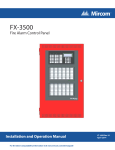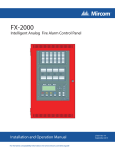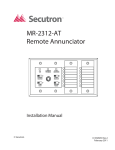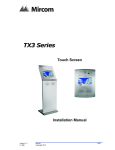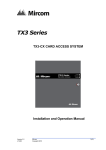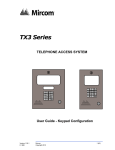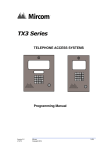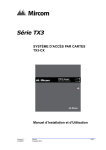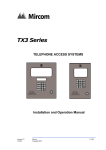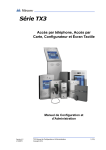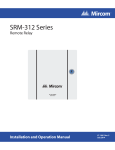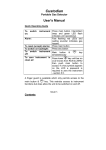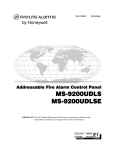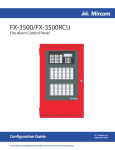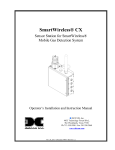Download RAM 7.0 Specifications
Transcript
RAM-3500-LCD Remote Annunciator Installation and Operation Manual LT-1093 Rev. 1 July 2014 Table of Contents 1.0 Introduction 6 1.1 Contact Us ..................................................................................................................... 6 2.0 Mechanical Installation 2.1 Mounting Dimensions .................................................................................................... 8 3.0 Configuring the Main Board 3.1 RAM-3500-LCD Main Board Components ..................................................................... 11 3.2 Dip Switches .................................................................................................................. 12 3.2.1 Setting the RAM-3500-LCD Address ............................................................................. 12 4.0 Wiring 4.1 RAM-3500-LCD Wiring .................................................................................................. 15 5.0 Operation 5.1 LCD Display ................................................................................................................... 16 5.2 Numeric Keypad and Cursor Buttons ............................................................................ 17 5.3 Common LED Indicators and Control Buttons ............................................................... 17 5.3.1 Flash Rates .................................................................................................................... 21 6.0 Specifications 6.1 Electrical Specifications ................................................................................................. 22 6.2 Current Drain for Battery Calculations ........................................................................... 22 6.3 Environmental Specifications ......................................................................................... 22 7.0 Warranty & Warning Information 8 11 14 16 22 23 3 List of Figures 4 Figure 1 Mounting the BB-1001 backbox directly to the wall ....................................................... 9 Figure 2 Installing the Annunciator Cover Bracket onto the RAM-3500-LCD .............................. 10 Figure 3 RAM-3500-LCD Remote Annunciator Main Board Layout ............................................. 11 Figure 4 Power Supply and RS-485 Wiring on the Main Board ................................................... 15 Figure 5 Numeric Keypad ............................................................................................................. 17 List of Tables Table 1 Table 2 Table 3 Table 4 Table 5 Table 6 Table 7 Table 8 Table 9 Table 10 Table 11 BB-1001 Backbox Dimensions ...................................................................................... BB-1002 Backbox Dimensions ...................................................................................... BB-1003 Backbox Dimensions ...................................................................................... BB-1008 Backbox Dimensions ...................................................................................... BB-1012 Backbox Dimensions ...................................................................................... RAM-3500-LCD Remote Annunciator Main Board Component Functions .................... RAM-3500-LCD Address Setting ................................................................................... Configuring Functions .................................................................................................... Wiring Table for Indicating and Auxiliary Power Circuits ............................................... Numeric Keypad and Cursor Buttons ............................................................................ LED Indicators and Control Buttons ............................................................................... 8 8 8 8 8 11 12 13 14 17 18 5 Introduction 1.0 Introduction The RAM-3500-LCD Remote Annunciator is used as a component of an FX-3500/MR-2350 Fire Alarm System. It provides an exact mimic of the FX-3500/MR-2350 display at a remote location. The RAM-3500-LCD features the following: i • 4 line LCD display. • Common feature LEDs and push buttons. • Alpha numeric keypad for the LCD. Note: Configuring FX-3500/MR-2350 Series fire alarm panels from this remote annunciator is not permitted. Each RAM-3500-LCD has its own address. Addresses available are 1 to 7 inclusive. This annunciator may be selected to operate as an ancillary device by using the system configurator and using DIP Switch SW1 to disable all buttons except: i • Lamp Test. • Buzzer Silence. • Info and Arrow Buttons. Note: The ancillary device option takes priority over any other selections made on DIP Switch. For more information on how to configure the RAM-3500-LCD as an ancillary device, see Describes the Jumpers, Ports, Switches and Potentiometer on the Main Board. on page 11. 1.1 Contact Us For General Inquiries, Customer Service and Technical Support you can contact us Monday to Friday 8:00 A.M. to 5:00 P.M. E.S.T. 6 Introduction General Inquiries Toll Free 1-888-660-4655 (North America Only) Local 905-660-4655 Email [email protected] Customer Service Toll Free 1-888-MIRCOM5 (North America Only) Local 905-695-3535 Toll Free Fax 1-888-660-4113 (North America Only) Local Fax 905-660-4113 Email [email protected] Technical Support Toll Free 1-888-MIRCOM5 (North America Only) Local 905-695-3535 Email [email protected] Website www.mircom.com 7 Introduction 2.0 Mechanical Installation The RAM-3500-LCD can be surface mounted using one of the BB-1000 series semi-flush enclosures. The following table gives the backboxes, their dimensions, and their capacity. Backbox Model Dimensions Chassis Capacity BB-1001 9.00”H x 12.75”W x 1.20”D 1 BB-1002 18.00”H x 12.75”W x 1.20”D 2 BB-1003 26.4”H x 12.75”W x 1.2”D 3 BB-1008 33”H x 22.5”W x 1.25”D 8 BB-1012 45”H x 22.5”W x 1.25”D 12 These enclosures may also be mounted to a 4” square electrical box. 2.1 Mounting Dimensions Table 1 BB-1001 Backbox Dimensions Backbox Dimensions 9.00”H x 12.75”W x 1.20”D Horizontal distance between mounting screws 9.95” Vertical distance between mounting screws 7.50” Table 2 BB-1002 Backbox Dimensions Backbox Dimensions 18.00”H x 12.75”W x 1.20”D Horizontal distance between mounting screws 9.95” Vertical distance between mounting screws 16.5” Table 3 BB-1003 Backbox Dimensions Backbox Dimensions 26.4”H x 12.75”W x 1.20”D Horizontal distance between mounting screws 9.95” Vertical distance between mounting screws 24.90” Table 4 BB-1008 Backbox Dimensions Backbox Dimensions 33”H x 22.5”W x 1.25”D Horizontal distance between mounting screws 20.9” Vertical distance between mounting screws 35.2” Table 5 BB-1012 Backbox Dimensions 8 Backbox Dimensions 45”H x 22.5”W x 1.25”D Horizontal distance between mounting screws 20.9” Vertical distance between mounting screws 52.0” Introduction How to mount the BB-1000 Series enclosures directly to the wall 1. Open the front door. 2. Mount the backbox to the wall using the four screws provided. BACKBOX WALL DOOR BACKBOX CAN BE MOUNTED WITH STANDARD 4" X 4" ELECTRICAL BOXES 12.75" B H A 1.2" BB-1001 BACKBOX IS SHOWN #6-32 HEXNUTS ANNUNCIATOR CHASSIS Figure 1 Mounting the BB-1001 backbox directly to the wall 9 Introduction How to mount the Annunciator Cover Bracket onto the RAM-3500-LCD 1. Place the RAM-3500-LCD into the backbox, ensure that the mounting holes on the annunciator line up with the studs in the backbox. 2. Place the Annunciator Cover Bracket over the RAM-3500-LCD and use the nuts provided with the backbox to secure the assembly. Refer to the figure below. Figure 2 10 Installing the Annunciator Cover Bracket onto the RAM-3500-LCD Introduction 3.0 Configuring the Main Board SW2 ADDRESS SW1 CONFIG Figure 3 3.1 P2 DISPLAY EXPANSION OUT + IN - + OUT - + IN - 24 VDC S RS-485 + OUT - S JW1 EOL RAM-3500-LCD Remote Annunciator Main Board Layout RAM-3500-LCD Main Board Components Describes the Jumpers, Ports, Switches and Potentiometer on the Main Board. Table 6 RAM-3500-LCD Remote Annunciator Main Board Component Functions Component Function JW1 EOL. If annunciator is last in line move jumper to right most pins. P2 Connect to RAX-1048TZDS with a ribbon cable. SW1 Configures specific functions. For more information see Table 8 Configuring Functions on page 13. SW2 Configures address of RAM-3500-LCD. For more information see SW2 configures the address of the RAM-3500-LCD. Address 1 to 7 inclusive are valid for all RAM-3500-LCD Annunciators in the system. Table 7 RAM3500-LCD Address Setting describes the switch settings for each address. on page 12 11 Introduction 3.2 Dip Switches The RAM-3500-LCD utilizes two DIP switches for configuring the address and available functions. 3.2.1 Setting the RAM-3500-LCD Address SW2 configures the address of the RAM-3500-LCD. Address 1 to 7 inclusive are valid for all RAM-3500-LCD Annunciators in the system. Table 7 RAM-3500-LCD Address Setting describes the switch settings for each address. Table 7 RAM-3500-LCD Address Setting Address DIP Switch Setting 0 1 5 0 0 6 0 0 12 1 2 3 4 ON 1 1 1 0 0 4 1 7 0 0 1 1 2 3 4 1 2 3 4 ON 0 1 2 3 4 ON 3 1 0 1 1 1 1 2 3 4 ON 0 1 2 3 4 ON 2 0 0 0 1 DIP Switch Setting ON 1 0 1 2 3 4 ON 1 Address Introduction 3.2.2 Configuring Functions SW1 configures the functions of the RAM-3500-LCD. Table 8 Configuring Functions describes the switch settings for each function. Table 8 Configuring Functions Function 1 2 3 4 5 6 7 8 1 2 3 4 5 6 7 8 ON 1 2 3 4 5 6 7 8 ON 1 2 3 4 5 6 7 8 ON 1 2 3 4 5 6 7 8 ON 1 2 3 4 5 6 7 8 Disable Set switch to ON ON 5 1 2 3 4 5 6 7 8 ON Buzzer Silence 4 1 2 3 4 5 6 7 8 ON Lamp Test Button 3 1 2 3 4 5 6 7 8 ON Fire Drill Button 2 1 2 3 4 5 6 7 8 ON Signal Silence Button 1 Enable Set switch to OFF ON System Reset Button Switch # 13 Introduction 4.0 Wiring The RS-485 Wiring to the RAM-3500-LCD is recommended to be Twisted Shielded Pair. The wire must follow: • 300mA power limited • 22 AWG maximum of 2000 feet • 20 AWG maximum of 4000 feet • 18 AWG maximum of 8000 feet • Maximum 40 ohm loop resistance The 24VDC field wiring needs to be of an appropriate gauge for the number of annunciators and the total wiring run length. See 6.2 Current Drain for Battery Calculations on page 22 to calculate the Maximum current for all annunciators summed together. For information on wiring the RAX-1048TZDS Annunciator Adder Modules to the Main Board see RAX-1048TZDS. i Note: ! All circuits are power limited and must use type FPL, FPLR or FPLP Power Limited Cable. Attention: Accidentally connecting any of the 24V DC wires to the RS-485 wiring will result in damage to the Annunciator and/or to the Fire Alarm Control Panel to which it is connected. Table 9 Wiring Table for Indicating and Auxiliary Power Circuits Total Maximum Current for all Annunciators 14 Maximum Wiring Run to Last Annunciator 18AWG 16AWG 14AWG 12AWG Max. Loop Resistance Amperes ft m ft m ft m ft m Ohms 0.06 2350 716 3750 1143 6000 1829 8500 2591 30 0.12 1180 360 1850 567 3000 915 4250 1296 15 0.30 470 143 750 229 1200 366 1900 579 6 0.60 235 71 375 114 600 183 850 259 3 0.90 156 47 250 76 400 122 570 174 2 1.20 118 36 185 56 300 91 425 129 1.5 1.50 94 29 150 46 240 73 343 105 1.2 1.70 78 24 125 38 200 61 285 87 1.0 Introduction 4.1 RAM-3500-LCD Wiring + + + S + S - Figure 4 i Note: Power Supply and RS-485 Wiring on the Main Board RS-485 connection is supervised locally by both the FACP and annunciator. All circuits are power limited and supervised. 15 Introduction 5.0 Operation 5.1 LCD Display The display is a four line, 20 character back-lit alphanumeric LCD. It displays information regarding the panel, its circuits, and devices. An on-screen cursor is controlled by the cursor buttons for menu selection and control. Report information provided by the LCD display includes: • Alarm Log • Event Log • Current Levels • Device Information • Verification and Maintenance Reports Use the cursor buttons on the Numeric Keypad for menu selection and control. For more information see 5.2 Numeric Keypad and Cursor Buttons. 16 Introduction 5.2 Numeric Keypad and Cursor Buttons Table 10 Numeric Keypad and Cursor Buttons Key 2 ABC 4 GHI 6 MNO 8 TUV X M ? 1 2 ABC 3 X 6 M 9 ? DEF Description Key 2 (Up cursor) Press this button to move the cursor or scroll up lists in a continuous loop. Key 4 (Left Cursor) Press this button to move the cursor or select options to the left. 4 5 GHI JKL 7 8 PRS TUV * 0 QZ MNO WXY # Key 6 (Right Cursor) Press this button to move the cursor or select options to the right. Figure 5 Numeric Keypad Key 8 (Down Cursor) Press this button to move the cursor or scroll down lists in a continuous loop. Cancel Button Press this button to cancel an operation or exit a menu. Menu Button Press this button to view the command menu. Info Button Press this button for detailed information about a displayed item. Enter Button Press this button to select a displayed item. Star Button * # 5.3 Press this button to move the cursor to the left for certain configurations such as entering a device address. Hash Button Press this button to move the cursor to the right for certain configurations such as entering a device address. Common LED Indicators and Control Buttons 17 Introduction For complete descriptions of all LED indicators and control buttons see the following table. Table 11 LED Indicators and Control Buttons LED Indicator and Control Buttons Description AC On Indicator Illuminates steady green when the main AC power is within acceptable levels. The LED turns off when the level falls below the power-fail threshold and the panel is switched to standby (battery) power. Ground Fault Indicator Flashes yellow at the Trouble rate when a Ground Fault is detected on any field wiring. Clearing the Ground Fault clears the indication and turns the LED off. CPU Fault Indicator Flashes yellow at the Trouble rate when the processor ceases functioning. Battery/Charger Trouble Flashes yellow at the Slow Flash rate. Clearing the trouble condition clears the indication and turns the LED off. Alarm Queue Button and Indicator Flashes red when there is an alarm in queue. The buzzer sounds steady. An alarm can be generated in two ways • When any Alarm configured point or input activates. • Pressing the General Alarm button and the system is set for Two Stage operation. Pressing the Alarm Queue button allows the user to cycle through and review a list of active alarms from oldest to most recent. Once all alarms in the queue have been reviewed the LED will illuminate steady. Resetting the panel clears the indication and turns the LED off. Supervisory Queue Button and Indicator Flashes yellow at the Fast Flash Rate when a Latching or Non-Latching circuit is activated. The buzzer sounds at the fast rate. Pressing the Supervisory Queue button allows the user to cycle through and review a list of active supervisory alarms from oldest to most recent. Once all alarms in the queue have been reviewed the LED will illuminate steady. If all Non-Latching Supervisory circuits are restored and there are no Latching Supervisory Circuits active, the indication will clear and the LED will turn off. Resetting the panel will clear the activation of any Latching Supervisory Alarms, clears the indication and turns the LED off. 18 Introduction Table 11 LED Indicators and Control Buttons (Continued) LED Indicator and Control Buttons Description Trouble Queue Button and Indicator Flashes yellow when any trouble condition is detected on the panel. The buzzer sounds at the slow rate. Pressing the Trouble Queue button allows the user to cycle through and review a list of active Troubles from oldest to most recent. Once all troubles in the queue have been reviewed the LED will illuminate steady. Clearing all Trouble conditions clears the indication and turns the LED off. Building Queue Button and Indicator Flashes yellow at the Trouble Flash rate when any Building condition is detected on the panel. The buzzer sounds at the fast rate. Pressing the Building Queue button allows the user to cycle through and review a list of active Building Conditions from oldest to most recent. Once all conditions in the queue have been reviewed the LED will illuminate steady. Clearing all Building conditions clears the indication and turns the LED off. System Reset Button and Indicator The System Reset button resets the Fire Alarm Control Panel and all Circuits. Pressing the System Reset button causes a trouble to occur and the LED to illuminate steady yellow. The following events will occur • Resets all Latching, Trouble Conditions. • Resets all Initiating Circuits. • Resets 4-Wire Smoke Supply and Aux. Power Supply. • Turns off all Indicating Circuits. • Turns off Signal Silence, Ack & GA Indicators. • Turns off Fire Drill. • Stops and resets all Timers. • Processes inputs as new events. • Aux Disconnect is not affected. • Reset cannot be activated until the Signal Silence Inhibit timer has expired. Resetting the System clears the indication and turns the LED off. Alarm Acknowledge Button and Indicator - Two Stage Operation and Positive Alarm Sequence LED and Indicator are active only when the Panel is configured for Two Stage Operation or Positive Alarm Sequence. Flashes yellow at the Fast Flash Rate as the Auto General Alarm Timer is timing. Illuminates steady yellow by pressing the Acknowledge or Signal Silence buttons and cancelling the Auto General Alarm Timer. The expiring of the Auto General Alarm Timer causes the Panel to enter General Alarm, clears the indication and turns the LED off. 19 Introduction Table 11 LED Indicators and Control Buttons (Continued) LED Indicator and Control Buttons Description Automatic Alarm Signal Cancel Button and Indicator Automatic Alarm Signal Cancel LED and Indicator are active only when the Panel is configured for PAS or Two Stage Operation. Flashes yellow at the Fast Flash Rate as the Auto General Alarm Timer is timing. If the panel is configured for Positive Alarm Sequence (PAS), activation of the Acknowledge button within 15 seconds of a PAS alarm will delay a common alarm activation for 180 seconds. The expiring of the Auto General Alarm Timer causes the Panel to enter General Alarm, clears the indication and turns the LED off. General Alarm Button and Indicator - Two Stage Operation or PAS LED and Indicator are active only when the Panel is configured for Two Stage Operation or PAS. LED illuminates steady red when the following occurs: • Pressing the General Alarm button. • Activating a General Alarm Initiating Circuit. • The Auto General Alarm Timer expiring. Resetting the System clears the indication and turns the LED off. Signal Silence/Releasing Service Signal Silence Button and Indicator Use Releasing Service Signal Silence for releasing operation and Signal Silence for other modes. Flashes yellow at the Trouble Flash rate when Indication Circuits are silenced by the following: • Pressing the Signal SIlence button. • The Auto Signal SIlence Timer. Any Subsequent Alarms cause the Signals to resound, clears the indication and turns the LED off. Pressing the Signal Silence button when the Panel is in Alarm turns on the Signal Silence Indicator and deactivates any Silenceable Indicating Circuits. NonSilenceable Circuits are unaffected. Signals will re-sound upon any subsequent Alarm. This button does not function during one of the following: • Any configured Signal Silence Inhibit Timer period. • If Fire Drill has activated the Indicating Circuits. Additional Two Stage Function If the Auto General Alarm Timer has not expired, this Signal Silence button also performs the same function as the Alarm Acknowledge button. Buzzer Silence Button and Indicator Flashes yellow at the Trouble Flash rate when the Buzzer Silence button is pressed. Any new alarm, supervisory or trouble events resounds the buzzer and will cause the Buzzer Silence LED to turn off. 20 Introduction Table 11 LED Indicators and Control Buttons (Continued) LED Indicator and Control Buttons Description Auxiliary Disconnect Button and Indicator Activating the Auxiliary Disconnect button activates the Auxiliary Disconnect function. The Auxiliary Alarm Relay is always disconnected with this button. The Common Alarm Relay, the Common Supervisory relay and all correlated alarm relays may be disconnected as selected through configuration. Activating the Auxiliary Disconnect button also causes the Common Trouble LED to illuminate steady, the common trouble relay to send a trouble message and the trouble buzzer to flash at the trouble flash rate. Pressing the Auxiliary Disconnect button again de-activates this function and the system will go back to normal. Visual Indicator Test Button and Indicator Visual Indicator Test Pressing the Visual Indicator Test button illuminates all front panel LEDs on steady in the appropriate color and turns the buzzer on steady. If Visual Indicator Test is active for more than 10 seconds, Common Trouble is activated. Fire Drill Button and Indicator Illuminates steady yellow during an active Fire Drill. Pressing the Fire Drill button activates all programmed and non-Disconnected Indicating Circuits. It does not transmit any Alarms via the City Tie, or Common Alarm Relay. Fire Drill may be programmed to operate specific NAC Circuits. Fire Drill is cancelled by pressing the button again (toggle switch), or if the Panel goes into a real Alarm. 5.3.1 Flash Rates Fast Flash 120 flashes per minute, 50% duty cycle. Trouble Flash 20 flashes per minute, 50% duty cycle. 21 Introduction 6.0 Specifications 6.1 Electrical Specifications 24 VDC power limited nominal voltage Standby 70mA Max., Alarm 100mA Max. All LEDs illuminated 40 mA Max. 6.2 Current Drain for Battery Calculations The maximum normal current drain will be during Lamp Test when all lamps are illuminated on one chassis at a time. Thus the currents are: • Normal Standby = 70mA • Maximum = 100mA The Normal Standby Current is used for battery size calculations (see the FX-3500/MR-2350 Fire Alarm Control Panel manual for battery calculations) and includes the current drain for the Trouble Buzzer, Trouble LED, and one Alarm LED. The Maximum Current is used to calculate the wire size (see ‘section above). 6.3 Environmental Specifications This annunciator is intended for indoor use only. 22 Introduction 7.0 Warranty & Warning Information Warning Please Read Carefully Note to End Users: This equipment is subject to terms and conditions of sale as follows: Note to Installers This warning contains vital information. As the only individual in contact with system users, it is your responsibility to bring each item in this warning to the attention of the users of this system. Failure to properly inform system end-users of the circumstances in which the system might fail may result in over-reliance upon the system. As a result, it is imperative that you properly inform each customer for whom you install the system of the possible forms of failure. System Failures This system has been carefully designed to be as effective as possible. There are circumstances, such as fire or other types of emergencies where it may not provide protection. Alarm systems of any type may be compromised deliberately or may fail to operate as expected for a variety of reasons. Some reasons for system failure include: •Inadequate Installation A Fire Alarm system must be installed in accordance with all the applicable codes and standards in order to provide adequate protection. An inspection and approval of the initial installation, or, after any changes to the system, must be conducted by the Local Authority Having Jurisdiction. Such inspections ensure installation has been carried out properly. •Power Failure Control units, smoke detectors and many other connected devices require an adequate power supply for proper operation. If the system or any device connected to the system operates from batteries, it is possible for the batteries to fail. Even if the batteries have not failed, they must be fully charged, in good condition and installed correctly. If a device operates only by AC power, any interruption, however brief, will render that device inoperative while it does not have power. Power interruptions of any length are often accompanied by voltage fluctuations which may damage electronic equipment such as a fire alarm system. After a power interruption has occurred, immediately conduct a complete system test to ensure that the system operates as intended. •Failure of Replaceable Batteries Systems with wireless transmitters have been designed to provide several years of battery life under normal conditions. The expected battery life is a function of the device environment, usage and type. Ambient conditions such as high humidity, high or low temperatures, or large temperature fluctuations may reduce the expected battery life. While each transmitting device has a low battery monitor which identifies when the batteries need to be replaced, this monitor may fail to operate as expected. Regular testing and maintenance will keep the system in good operating condition. •Compromise of Radio Frequency (Wireless) Devices Signals may not reach the receiver under all circumstances which could include metal objects placed on or near the radio path or deliberate jamming or other inadvertent radio signal interference. •System Users A user may not be able to operate a panic or emergency switch possibly due to permanent or temporary physical disability, inability to reach the device in time, or unfamiliarity with the correct operation. It is important that all system users be trained in the correct operation of the alarm system and that they know how to respond when the system indicates an alarm. •Automatic Alarm Initiating Devices Smoke detectors, heat detectors and other alarm initiating devices that are a part of this system may not properly detect a fire condition or signal the control panel to alert occupants of a fire condition for a number of reasons, such as: the smoke detectors or heat detector may have been improperly installed or positioned; smoke or heat may not be able to reach the 23 Introduction alarm initiating device, such as when the fire is in a chimney, walls or roofs, or on the other side of closed doors; and, smoke and heat detectors may not detect smoke or heat from fires on another level of the residence or building. •Software Most MGC products contain software. With respect to those products, MGC does not warranty that the operation of the software will be uninterrupted or error-free or that the software will meet any other standard of performance, or that the functions or performance of the software will meet the user’s requirements. MGC shall not be liable for any delays, breakdowns, interruptions, loss, destruction, alteration or other problems in the use of a product arising our of, or caused by, the software. Every fire is different in the amount and rate at which smoke and heat are generated. Smoke detectors cannot sense all types of fires equally well. Smoke detectors may not provide timely warning of fires caused by carelessness or safety hazards such as smoking in bed, violent explosions, escaping gas, improper storage of flammable materials, overloaded electrical circuits, children playing with matches or arson. Even if the smoke detector or heat detector operates as intended, there may be circumstances when there is insufficient warning to allow all occupants to escape in time to avoid injury or death. •Alarm Notification Appliances Alarm Notification Appliances such as sirens, bells, horns, or strobes may not warn people or waken someone sleeping if there is an intervening wall or door. If notification appliances are located on a different level of the residence or premise, then it is less likely that the occupants will be alerted or awakened. Audible notification appliances may be interfered with by other noise sources such as stereos, radios, televisions, air conditioners or other appliances, or passing traffic. Audible notification appliances, however loud, may not be heard by a hearingimpaired person. •Telephone Lines If telephone lines are used to transmit alarms, they may be out of service or busy for certain periods of time. Also the telephone lines may be compromised by such things as criminal tampering, local construction, storms or earthquakes. •Insufficient Time There may be circumstances when the system will operate as intended, yet the occupants will not be protected from the emergency due to their inability to respond to the warnings in a timely manner. If the system is monitored, the response may not occur in time enough to protect the occupants or their belongings. •Component Failure Although every effort has been made to make this system as reliable as possible, the system may fail to function as intended due to the failure of a component. •Inadequate Testing Most problems that would prevent an alarm system from operating as intended can be discovered by regular testing and maintenance. The complete system should be tested as required by national standards and the Local Authority Having Jurisdiction and immediately after a fire, storm, earthquake, accident, or any kind of construction activity inside or outside the premises. The testing should include all sensing devices, keypads, consoles, alarm indicating devices and any other operational devices that are part of the system. •Security and Insurance Regardless of its capabilities, an alarm system is not a substitute for property or life insurance. An alarm system also is not a substitute for property owners, renters, or other occupants to act prudently to prevent or minimize the harmful effects of an emergency situation. 24 Introduction IMPORTANT NOTE: End-users of the system must take care to ensure that the system, batteries, telephone lines, etc. are tested and examined on a regular basis to ensure the minimization of system failure. Limited Warranty Mircom Technologies Ltd., MGC Systems Corp. and MGC System International Ltd. together with their subsidiaries and affiliates (collectively, MGC) warrants the original purchaser that for a period of three years from the date of shipment, proprietary manufactured product shall be free of defects in materials and workmanship, under normal use. During the warranty period, MGC shall, at its option, repair or replace any defective product upon return of the product to its factory, at no charge for labor and materials. Non-proprietary, third party or OEM product shall be warranted in accordance with the warranty period of the manufacturer. Any replacement and/or repaired parts are warranted for the remainder of the original warranty or ninety (90) days, whichever is longer. The original owner must promptly notify MGC in writing that there is defect in material or workmanship, such written notice to be received in all events prior to expiration of the warranty period. International Warranty The warranty for international customers is the same as for any customer within Canada and the United States, MGC shall not be responsible for any customs fees, taxes, or VAT that may be due. Conditions to Void Warranty This warranty applies only to defects in parts and workmanship relating to normal use. It does not cover: •damage incurred in shipping or handling; •damage caused by disaster such as fire, flood, wind, earthquake or lightning; •damage due to causes beyond the control of MGC such as excessive voltage, mechanical shock or •water damage; •damage caused by unauthorized attachment, alterations, modifications or foreign objects; •damage caused by peripherals (unless such peripherals were supplied by MGC); •defects caused by failure to provide a suitable installation environment for the products; •damage caused by use of the products for purposes other than those for which it was designed; •damage from improper maintenance; •damage arising out of any other abuse, mishandling or improper application of the products. Warranty Procedure To obtain service under this warranty, please return the item(s) in question to the point of purchase. All authorized distributors and dealers have a warranty program. Anyone returning goods to MGC must first obtain an authorization number. MGC will not accept any shipment whatsoever for which prior authorization has not been obtained. NOTE: Unless specific preauthorization in writing is obtained from MGC management, no credits will be issued for custom fabricated products or parts or for complete fire alarm system. MGC will at its sole option, repair or replace parts under warranty. Advance replacements for such items must be purchased. 25 Introduction Note: MGC’s liability for failure to repair the product under this warranty after a reasonable number of attempts will be limited to a replacement of the product, as the exclusive remedy for breach of warranty. Disclaimer of Warranties This warranty contains the entire warranty and shall be in lieu of any and all other warranties, whether expressed or implied (including all implied warranties of merchantability or fitness for a particular purpose) and of all other obligations or liabilities. MGC neither assumes nor authorizes any other person purporting to act on its behalf to modify or to change this warranty, or to assume for it any other warranty or liability concerning this product. This disclaimer of warranties and limited warranty are governed by the laws of the province of Ontario, Canada. Out of Warranty Repairs MGC will at its option repair or replace out-of-warranty products which are returned to its factory according to the following conditions. Anyone returning goods to MGC must first obtain an authorization number. MGC will not accept any shipment whatsoever for which prior authorization has not been obtained. Products which MGC determines to be repairable will be repaired and returned. A set fee which MGC has predetermined and which may be revised from time to time, will be charged for each unit repaired. Products which MGC determines not to be repairable will be replaced by the nearest equivalent product available at that time. The current market price of the replacement product will be charged for each replacement unit. The foregoing information is accurate as of the date of publishing and is subject to change or revision without prior notice at the sole discretion of the Company WARNING: Mircom recommends that the entire system be completely tested on a regular basis. However, despite frequent testing, and due to, but not limited to, criminal tampering or electrical disruption, it is possible for this product to fail to perform as expected. NOTE: Under no circumstances shall Mircom be liable for any special, incidental, or consequential damages based upon breach of warranty, breach of contract, negligence, strict liability, or any other legal theory. Such damages include, but are not limited to, loss of profits, loss of the product or any associated equipment, cost of capital, cost of substitute or replacement equipment, facilities or services, down time, purchaser’s time, the claims of third parties, including customers, and injury to property. MIRCOM MAKES NO WARRANTY OF MERCHANTABILITY OR FITNESS FOR A PARTICULAR PURPOSE WITH RESPECT TO ITS GOODS DELIVERED, NOR IS THERE ANY OTHER WARRANTY, EXPRESSED OR IMPLIED, EXCEPT FOR THE WARRANTY CONTAINED HEREIN. 26 CANADA - Main Office 25 Interchange Way Vaughan, ON L4K 5W3 Tel: (888) 660-4655 (905) 660-4655 Fax: (905) 660-4113 U.S.A 4575 Witmer Industrial Estates Niagara Falls, NY 14305 Tel: (888) 660-4655 (905) 660-4655 Fax: (905) 660-4113 TECHNICAL SUPPORT North America Tel: (888) Mircom5 (888) 647-2665 International Tel: (905) 647-2665 © MGC 2014 Printed in Canada Subject to change without prior notice www.mircomgroup.com





























